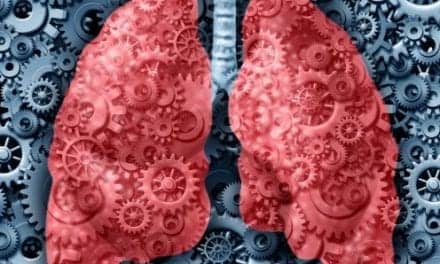
Pulmonary arterial hypertension (PAH) or pulmonary hypertension (PH) is a rapidly progressing disorder in which there is a high degree of morbidity and mortality. By definition, PH is a disorder affecting the endothelium of the lung vasculature, resulting in a narrowing of the pulmonary arteries with an elevated mean pulmonary arterial pressure of 21 to 24 mm Hg or greater at rest; normal values range from 8 to 20 mm Hg.1 This consistently elevated pulmonary artery pressure will often lead to cardiac insult, causing right ventricular hypertrophy and ultimately right ventricular failure.1 The disease is defined pathologically as one in which there is progressive vascular proliferation leading to occlusive vascular lesions and damage to the smallest of the pulmonary arteries.2 The clinical progression is marked by dyspnea, exercise intolerance, increased pulmonary vascular resistance, and, at end stage, right ventricular failure leading to death. Pulmonary arterial hypertension is considered a life-threatening condition, and if left untreated for an extensive period of time, the prognosis is extremely poor.
To review how the pulmonary vessels regulate their vascular pressure, we will take a look at the physiology. According to Respiratory Physiology,3 the resistance within a circuit is affected by the diameter of the pathways comprising the circuit. The resistance or tone of the pulmonary vasculature is controlled by smooth muscles that surround the pulmonary arteries, regulating their diameter, with the case being the same for extra-pulmonary arterial circuits. The significant difference between the pulmonary and systemic arterial systems lies in how the smooth muscle is innervated to create the tone of the artery. For the systemic vasculature, the balance of vascular tone is provided by the delicate balance of the parasympathetic and sympathetic nervous systems.3 The pulmonary arterial circuit does not respond well to these neural inputs, instead responding best to chemical mediators. For example, the effect of oxygen on the pulmonary arteries is dilation, while low levels of oxygen promote vascular constriction. The exact mechanism for oxygen as a pulmonary vasodilator is not well understood. In contrast, vascular dilation occurs in hypoxic tissue, which would allow for greater delivery of oxygen to the affected area. Another common pulmonary artery mediator is nitric oxide (NO), which is produced by nitric oxide synthase within the endothelial cell membranes. Nitric oxide is the most potent pulmonary endogenous vasodilator known.3 Nitric oxide works on a positive feedback system, meaning that as pulmonary blood flow increases, the production of NO increases, resulting in greater vasodilatation and ultimately increased pulmonary blood flow without a great increase in resistance. With the positive feedback, when cardiac output increases, the pulmonary blood flow increases with no increase in resistance, allowing the right ventricle to perform optimally and an adequate preload placed on the left side of the heart to maintain systemic pressure and flow demands. The development of PAH demonstrates a lack of response from the vasculature to relax and promote a lower pulmonary systemic pressure.
The classification of PAH has evolved over the last 10 years. The older classification system for PAH had two categories, idiopathic pulmonary hypertension (IPAH) and secondary PAH. Within this dual classification system laid one problem: many of the secondary forms of PAH resembled those of IPAH, and it was difficult to distinguish a cause. The World Health Organization sought to establish a more definitive classification system and identified five categories, which are summarized in the Table.4

The classification system brings to the forefront the many causes for elevated pulmonary artery pressures, and therefore one can see that a simple diagnosis of pulmonary hypertension is far from “simple.” Once it is diagnosed, the clinical investigation begins to determine if the patient has PAH that is solely related to a problem with the pulmonary vasculature or whether the PAH is secondary to problems existing within other organ systems. Ruling out causes and gathering information is a tedious diagnostic process that may reveal nothing other than IPAH. There are many unanswered questions about PAH, and, as respiratory therapists, it is crucial that we know the disease’s impact on populations, specific trends, and unique etiologies that are under investigation.
Demographics and Gender for Pulmonary Hypertension
Pulmonary hypertension has long been notorious for its higher prevalence among women, and, according to data from modern registries of PAH, this is a supported fact. A national surveillance for PAH conducted between 1980 and 2002 has yielded some obvious trends.5 The death rate over those years increased from 5.2 to 5.4 per 100,000 population and was more prominent in African Americans (4.6 to 7.3 per 100,000) and in women (3.3 to 5.5 per 100,000). For men, it was quite the contrary, with a decrease in the death rate from 8.2 to 5.4 per 100,000 population. Consider, though, that recognition, treatment, and reporting of the disease most likely changed over this 22-year period, which may have been a contributor to the statistics. One of the most shocking statistics over the last 22 years is the increase in the hospitalization rate from 40.8 to 90.1 per 100,000 population, and from 1994 on, the most common cause for hospitalization with PAH was PAH associated with left-sided heart failure (Group 2 PH).5
More specific to the gender bias, one major registry that was sponsored by Actelion called REVEAL (Registry to Evaluate Early and Long-term PAH Disease Management) was able to identify a large gender bias within the observational study.6 The study revealed a stunning statistic: Of 2,525 adult patients diagnosed with PAH, 79.5% were females. This represents a 4:1 ratio of women to men. Other registries also demonstrate the female bias but to a lesser degree. The French Registry yielded a 1.9:1 ratio, and a National Institutes of Health study reported a 1.7:1 ratio. Nevertheless, it is obvious that more women than men are afflicted with PAH.6
The question is, what makes PAH more prevalent in women? The answer is not a refined one, and the reason women experience PAH more than men remains unclear. One possible explanation for women having greater prevalence of PAH is simply a difference in hormones and, in particular, the sex hormones estrogen and progesterone. Oddly, though, it has been observed that although acutely elevated levels of estrogen have a pulmonary arterial vasodilatory effect (protective), chronically elevated levels of the same hormone are detrimental, contributing to pulmonary vascular proliferation resulting in PAH.6 In essence, the same hormone has both a positive and negative effect on the pulmonary vasculature. For example, women who are menstruating and have higher levels of estrogen show a decreased response to hypoxemia by the pulmonary arteries. In vitro, increased estrogen yields larger prostacyclin levels, resulting in higher nitric oxide production and thereby causing pulmonary artery relaxation.6 Looking at the bigger picture, the ultimate failure for all patients with PAH is from right ventricular hypertrophy followed by right-sided heart failure. Elevated pulmonary artery pressures create a greater systolic afterload and a larger diastolic volume, leading to increased pressures within the right ventricle. One study called MESA (Multi-Ethnic Study of Atherosclerosis) was able to isolate PAH and demonstrate that women participants had higher RV ejection fractions and lesser end-diastolic mass than the men.7 The French study notes that women with IPAH had improved survival at 3 years, even though treatments were similar for both men and women.6 Thoughts and investigations as to why women survive longer with PAH and have better RV function are focusing on estrogen and its effect on the right ventricle. So, the very same hormone that may contribute to PAH in women may also support them by promoting a compensatory process within the right ventricle. More research is needed on the effects of estrogen on the right ventricle and its contribution to survival in women with PAH.
Genes and PAH, Is It a Hereditary Disease?
Since 1951, there has been a strong suspicion that PAH has a genetic component. Research began with the description of primary pulmonary hypertension by Dresdale and colleagues.8 In 1954, a family was identified in which a mother, her son, and her sister were all identified to have PAH. This led to the identification of an altered transforming growth factor signaling by the Bone Morphogenic Protein Receptor Type 2 or BMPR2. Continuing on this familial-lineage research of PAH, a total of 14 families have been identified and studied for their hereditary lineage of PAH. The 14th family to be added for study and presented in the literature has a total of six deaths, all women, and 36 members with PAH, 29 of whom are females, supporting the 4:1 ratio described in the REVEAL study.2 The inheritance occurs on an autosomal dominant basis meaning that only one parent needs to carry the gene in order for the disease to express itself. What is most intriguing about the genetic behavior of hereditary PAH (HPAH) is its wide range of expression, which is 20% to 80%.2 Therefore, if expression is low and the genetic capacity is there to support the development of PAH, then there must be contributing factors that support the disease’s expression. There are many factors that contribute to the expression of genes and the manifestation of a disease, such as the environment, other genetic abnormalities, lifestyle, etc. Each of these in conjunction with the genetic predisposition may vary the penetrance of the disease. Another important genetic process to note is genetic anticipation. This is when a disease begins to manifest itself at an earlier and earlier age from one generation to the next. So one generation may express the disorder in their 70s while the next expresses the disorder in their 50s and so on; there have been reports of this occurring for HPAH.2
With the knowledge that PAH has been investigated for many years, registries have been running for over 2 decades, and data are being captured from many national and ethnic groups. It is hoped that a better understanding of the disease will emerge, resulting in less delay of treatment, expedited identification of a secondary cause, and more refined therapy, all resulting in less morbidity and decreased mortality for what remains to be a disease with poor prognosis.
Michael T. Provencher, RRT, MPH, is manager for respiratory care, Mercy Hospital, Portland, Me. For further information, contact [email protected].
References
- Badesch DB, Champion HC, Sanchez MA, et al. Diagnosis and assessment of pulmonary arterial hypertension. J Am Coll Cardiol. 2009;54(1 Suppl):S55-66.
- Fessel JP, Loyd JE, Austin ED. The genetics of pulmonary arterial hypertension in the post-BMPR2 era. Pulm Circ. 2011;1:305-19.
- Schwartzstein RM, Parker MJ. Respiratory Physiology: A Clinical Approach. 1st ed. Philadelphia: Lippincott Williams and Wilkins; 2006.
- Monteiro BC, McArdle JR. Comorbidities in pulmonary arterial hypertension. Minerva Pneumologica. 2008;47:127-42.
- Hyduk A, Croft JB, Ayala C, Zheng K, Mensah GA. Pulmonary hypertension surveillance—United States. MMWR Surveill Summ. 2005;54:1-28.
- Austin ED. Gender, Sex Hormones, and Pulmonary Arterial Hypertension. Available at: www.phaonlineuniv.org/node/7734/gender-sex-hormones-and-pulmonary-arterial-hypertension. Accessed April 18, 2012.
- Ventetuolo C. The Gender/Estrogen Paradox and the Right Ventricle in Pulmonary Vascular Disease. Available at: www.phaonlineuniv.org/node/7734/clinical-trials-update-genderestrogen-paradox-and-right-ventricle-pulmonary-vascular-disea. Accessed April 18, 2012.
- Dresdale DT, Michtom RJ, Schultz M. Recent studies in primary pulmonary hypertension, including pharmacodynamic observations on pulmonary vascular resistance. Bull N Y Acad Med. 1954;30:195–207.









